

Robert G. Hoyland. In God’s Path: The Arab Conquests and the Creation of an Islamic Empire. New York. Oxford University Press, 2015. 1-230 pgs. 3 Maps, 1 Appendix, 1 Timeline, Dramatis Personae, 2 Genealogical Tables, Bibliography, Index.
The main objective of this work is to give a more balanced account of the Arab conquests than that given by 9th century Arab historians. These are faulted not so much for what they do say, but rather for what they omit in portraying the conquests as a miraculous feat, absent any obstacles standing in the way (2.) Hoyland attempts to accomplish this by adding some missing pieces: the process, the voice of the conquered, the pre-history of the conquests, and a broader geographical scope which includes the fringes of the growing state (2-6.) The focus of the book is socio-economic, but it also includes elements of culture, warfare, and religion. It is organized chronologically, beginning in the pre-conquest Near East, and moves forward until C.E. 750 when the military expansion fizzles out (3.) Hoyland focuses on the testimonies of non-Muslim sources, since they are the earliest extant ones. The narrative begins, like other works (cf. Kennedy), by focusing on the pre-Islamic Arabian Peninsula, which was situated on the frontiers of Byzantium and Sassanian Persia.
Hoyland objects to Jan Retsö’s stereotypical portrayal of pre-Islamic Arabs as “nomadic, camel-rearing, religiously fanatical warriors”, noting that this was how they were depicted by settled peoples (22.) Rather, he argues that they were not a homogenous group, and that they only later forged a common “Arab” identity. In addressing the question of what drove the conquests, he suggests that the common push factor is the availability of Byzantine and Sassanian booty, while pull factors include economic and environmental distress in the Arabian Peninsula, along with Islam. He is critical of those like Johnston and Donner, who downplay religious violence associated with the conquest, arguing instead that religious violence was the norm in the Middle East at that time, giving the Roman/ Byzantine Empire as an example (63.) Against Gabrieli, Hoyland argues that these Arab soldiers were not undisciplined barbarians, instead they included seasoned veterans who had fought for the Byzantine or Sassanian armies (94.) He lessens the role played by religious zeal, and instead stresses that played by organization, due to a simple two-fold plan of emigration to a garrison and the waging of jihad (96.) For Hoyland, the speed of the conquest is not entirely exceptional, for he argues that conquests by nomads tend to happen this way, and cites the Mongols as a prime example. In doing this he is staying true to his goal of adding more balance to the accounts of the early Muslim historians, who portrayed the conquest as nothing less than a miraculous event. He does the same with their characterization of the fifth caliph, Mu’awiya.
Hoyland argues that the unflattering view of this first Umayyad caliph given by 9th century Muslim historians was a revision on their part, done to establish their own religious authority, while simultaneously avoiding the alienation of pro-Umayyad and pro-Alid factions (134.) The flip side of portraying Mu’awiya unfavorably is the idealized picture that exists of the first four (Rashidun) caliphs. The outgrowths of this compromise were Sunnism, made up of those who accepted the compromise, and Shiism, consisting of pro- ‘Alids who were unwilling to (134-135.) Hoyland is also critical of the views of Olig and Puin, Donner, and Nevo, who all call into question Mu’awiya’s sincerity in his adherence to Islam in one way or another. He argues against this from the caliph’s own words to the Emperor Heraclius, which were unambiguously Islamic, and distinctly non-ecumenical in nature (136.) Like Donner however, he attributes to al-Malik and his successors the forging of a distinct “Islamic society” (157.) This included the process by which the conquered peoples adopted the religion (Islam), and the identity (Arab), of the conquerors, transforming it in the process through cultural blending (158.) Furthermore, Hoyland tells us that the broadening of Arab identity allowed non-ethnic Arabs to claim it by attaching themselves to Arab tribes. He mentions that two avenues through which non-ethnic Arabs could rise to prominence were by military service in a now professionalized army, or through Islamic scholarship. Once the conquest had reached its peak, then began the process of making an Islamic civilization, which is the focus of the final chapter.
With the revolution of the Abbasids also came the metamorphosis from empire to commonwealth, through the process of fragmentation into autonomous realms. This commonwealth shared a common identity which Hoyland terms “Islamdom”, paralleling it to Christendom in Western Europe (209.) He suggests two processes whereby a unique Islamic culture was formed as being the Arabization and Islamization of the conquered areas. The role of the Arabic language is highlighted, as it became the common tongue of the Muslim commonwealth. But the construction of Islamic culture was not a one-way street through which the conquerors imposed their religion and culture on the conquered, as Hoyland notes. Rather, there was cultural sharing that occurred between the two groups, and modern scholarship has emphasized the contributions of the Sassanians, along with the long-recognized contributions of the Byzantines (230.)
One of the strengths of this book is the author’s ability to present a fuller picture of the conquest, which of course was one of his main goals. To give one example, he accepts the role played by religion in the conquest, but not as one of fueling a religious zeal. Rather, it was one that provided a worldview that had things in common with Christianity and Judaism thereby making it palatable to those in the ancient Near East, and through which the conquered could be integrated into the community, bringing benefits to it (228-229.) To give another example, Hoyland accepts that there was a strong military component that facilitated the conquest, but he gives weight also to the role played by non-military strategies, such as a measure of leniency extended to the conquered, economic incentives, and a certain level of autonomy, which were all given in exchange for cooperation (228.) A final strength of this work is the attention paid to a wide variety of non-Muslim sources from the outskirts of the empire, such as Byzantines, Persians, Copts, Armenians, Chinese, Indian, along with others. This makes for a unique narrative, giving the intended balance.
I hope you have enjoyed this review. Please consider subscribing to the e-mail list to be notified about recent posts.












